Earlier this week on October 9th and 12th, two United States Naval Ships – in international waters in the Bab al-Mandab Strait between Arabia and Africa – were attacked by multiple anti-ship cruise missiles by Houthi rebels (Learn more about the Houthi rebels here) in Yemen who are supplied and supported by Iran. The C-802 anti-ship cruise missile which was also used to destroy a United Arab Emirates (UAE) ship, the HSV-2 Swift on October 1st (Click here to read an article and watch video of the attack) also in the Bab al-Mandab Strait. The Houthi attained C-802 is an upgraded export version of the Chinese YJ-82 anti-ship cruise missile that was exported to Iran.

The UAE’s HSV-2 Swift after it was attacked by Houthi C-802 anti-ship cruise missiles on October 1, 2016.
In response to both of these attacks, the USS Masson (DDG-87) an Aegis Air Defense Baseline-6 equipped ship was able to defend both itself and the USS Ponce (AFSB(I) 15) from multiple C-802 anti-ship cruise missiles and prevent them from hitting or damaging either U.S. ship. The USS Masson used its SPY-1 S-Band Radar to track and provide successful firing solutions through its processing systems to its on board air defense interceptors, the longer range Standard Missile-2 Block III, (SM-2) (Click here to learn more about the SM-2 missile) and the shorter range Evolved Seasparrow Missile (ESSM) (Click here to learn more about the ESSM). The USS Mason also used its Nulka anti-ship missile decoy system. The United States was able to strike back, after it defended itself from the Houthis, with an offensive strike using Tomahawks, a land-attack cruise missile, launched from the USS Nitze (DDG 94), which also used the Aegis system, to attack and destroy multiple Houthi’s land based targeting radars in Yemen.
These mobile, multi-mission, offensive and defensive weapons Aegis Destroyers are an invaluable and remarkable platform that has just saved 880 American Sailors and severely weakened the offensive capability of the Houthi rebel group to threaten other sea based platforms and ships of trade in international waters traveling between the Red Sea and the Gulf of Aden to the Indian Ocean.
It is a significant step and decision by the Commander and Chief, the President of the United States to both defend and then strike the Houthis, a rebel group in Yemen at war with a prominent United States ally, Saudi Arabia. For an administration that does not want to seek conflict, a red line was drawn and acted upon showing American leadership in a time of transition of Presidential power in the United States.
This act of “Don’t Tread on Me” – which is flagged on USS Navy ships – is enabled and empowered by a highly sophisticated complex and proven Aegis Weapon system that is the best in the world as a platform for air and missile defense.
In the world today, the cruise missile threat is prolific and exponential in its development, operations, modernization and has been demonstrated in combat in Syria, Israel and now off of Yemen this past year. The very sophisticated, maneuvering cruise missile testing and massive inventory of the Chinese military is a serious concern to the United States Aircraft Carrier battle groups operating in international waters in the Pacific.
There has to be great emphasis placed on increasing capacity and modernization of the United States cruise missile defense systems and interceptors on sea as well as land.
Great honor and merit of courage for leadership goes to Commander Chris Gilbertson and his sailors for defending the ship and the USS Ponce (AFSV(I) 15) from attack. Honor too goes to Commander Paul Kaylor and his sailors on USS Nitze (DDG 94) for striking back successfully to take out Houthi capabilities to further threaten ships in international waters off of the Bab al-Mandab Strait.
